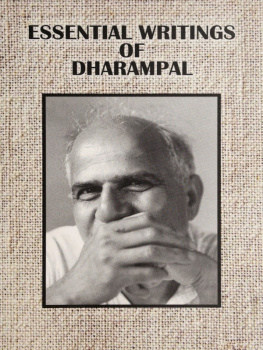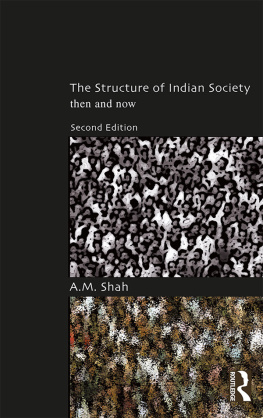
Essential writings of Dharampal
Pages
Essential writings of Dharampal
Dharampal, 1922-2006, author
Dharampal, Gita, editor
This book was produced in EPUB format by the Internet Archive.
The book pages were scanned and converted to EPUB format automatically. This process relies on optical character recognition, and is somewhat susceptible to errors. The book may not offer the correct reading sequence, and there may be weird characters, non-words, and incorrect guesses at structure. Some page numbers and headers or footers may remain from the scanned page. The process which identifies images might have found stray marks on the page which are not actually images from the book. The hidden page numbering which may be available to your ereader corresponds to the numbered pages in the print edition, but is not an exact match; page numbers will increment at the same rate as the corresponding print edition, but we may have started numbering before the print book's visible page numbers. The Internet Archive is working to improve the scanning process and resulting books, but in the meantime, we hope that this book will be useful to you.
The Internet Archive was founded in 1996 to build an Internet library and to promote universal access to all knowledge. The Archive's purposes include offering permanent access for researchers, historians, scholars, people with disabilities, and the general public to historical collections that exist in digital format. The Internet Archive includes texts, audio, moving images, and software as well as archived web pages, and provides specialized services for information access for the blind and other persons with disabilities.
Created with abbyy2epub (v.1.7.6)
| l 9 * 1 | '4 V'*' # * # | 1 w | tor* * | # | # |
# * * | % * | * ": #% * * | t #'% * | # * | ' # |
nr* | # i- 4)f | '* > r *># | % - I | 0 * | # to | to |
ft * ** | * * # * * $ | ft % '# | % * V* | % r | % |
# * w | *r**'if | ' * *_ | # > |
#% i | r*%*% t |
% i | * # % * f * ) |
4 % ft\ | p*% 1 | #% | Ip# | t | ., * y v %%# ^ # % # | * to | f | * t# | "f 1 i | It# | H | #% | 'y# | % | 9 - to to # 9 | # f|%4 n | % w f t't % to . * to ft to |
*# f | * ^ % | v | t | -j* ft | < ft | % * to # to to | to to | f * to | * t # to | * to | to * | i | .d# to | ft f ' to' to1 ^ | to to 'i ^ # to | *, '% * * 0 # : * to l# |
'' * 9 | t * | -* # | * #' | f to f * <| t ft to v | f | to | '!> pi i | to ft "| i | to' | i' | to | to to | 'to' | ' # p, | to to'-# to to to | :'V > t -to ,-* * #> ^ * i to H to'"# -f < |
to to %'t' | ## to* | to* | # *#' | * JHfr | *-#* to to %*% | # it | fr ft W | v | % | / w | * | V | f V | $ $, to- '- 1 # | to # # # ft # ;jto# to | , %- pi, p* * - r w* * f k |
,f f | rill | i % | ft | i f 1 | ft % ip % * * to to * to | 'to f | * | f 4# | ft to | | * | "# | v | # to- to ' to "v | # % to ,- ft ft f % | i * i* * * * * * ' |
% * to | % |
Contents
Preface vii
A Tribute ix
Introduction 1
1. Some Aspects of Earlier Indian Society and Polity and
their Relevance to the Present (1986) 31
2. Indian Science and Technology in the Eighteenth Century (1971) 83
3. Civil Disobedience and Indian Tradition (1971) 119
4. The Madras Panchayat System, vol.II (1972) 165
5. The Beautiful Tree: Indigenous Indian Education
in the Eighteenth Century (1983) 191
6. Indias Polity, its Characteristics and Current Problems (1992) 271
7. Bharatiya Chitta, Manas and Kala (1991/1993) 307
8. Reconsidering Gandhiji, 1915-1948 (1984) 355
DharampaTs Life and Work: A Chronology 379
DharampaTs Bibliography
Preface
Humanity on this planet earth has witnessed a rapid change during the last two and a half centuries. This change is taking place in the form of modernization through science, technology and industrializationa transformation which has destroyed the basic quality of human experience and sensitivity. In the process of such change in the name of development, humanity has faced two world wars and many continued conflicts in the form of declared and undeclared wars or acts of terrorism. Millions of people have perished as a direct result of this violence. Today, direct, indirect and structural violence has reached an extreme. Economic disparity, environmental degradation, civilizational conflicts, etc. threaten the survival of humanity and the very existence of the planet earth. In such a Dark Age, a miracle happened. That was the appearance of a unique individual, Mohandas Karamchand Gandhi. Despite having received, albeit partially, a modern western education, he was not deluded by western and modem civilization. Thanks to his unique wisdom and intellect, he was able to discriminate between truth and falsehood. Thus, he had the courage to renounce modem civilization in its totality, and he worked unceasingly to awaken the inner wisdom and restore the lost sensitivity integral to the human community. The concept of Swaraj, on the basis of tmth and non-violence, was established by means of Satyagraha, civil disobedience and non-cooperation movements. Gandhis teachings and practical experiments have created a completely new paradigm in human history. The non-violent revolution has enabled many people and nations to become free from external as well as inner domination. But unfortunately, many people could not understand Gandhis philosophy either due to the inadequacy of their spiritual strength or due to their self-centered motivation. After Gandhis martyrdom, the Indian leadership conveniently reduced the Mahatma to an object to be remembered occasionally by erecting his statues and garlanding them. Faced with this predicament, a great sage, Shri Dharampal, opened countless peoples eyes by giving them the most appropriate method and information to understand Gandhi. Dharampals tireless efforts in finding and documenting the irrefutable evidence for substantiating Gandhis statements and discourses are remarkable. Persons like me, without the help of Dharampals guidance, would not have been able to understand the deepest and subtlest philosophy of the Mahatma. Therefore,
Next page











